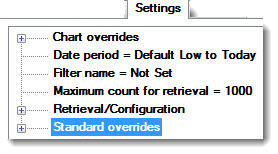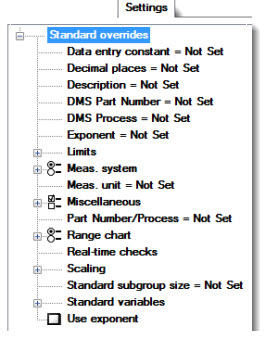
If you want to analyze data as if its standards were configured differently—without actually changing those standards—you can expand the Standard overrides tree and change the settings.
The Standard overrides node is located at the top level on the Settings tab:

For help with using tree structures like the one on the Settings tab, see Navigating Tree Structures

Some of the standard settings will impact the statistics you report in different ways. These standard settings can be grouped as follows:
Standard override setting: |
Affects this statistic: |
Data entry constant |
|
Description |
|
DMS Part Number |
|
DMS Process |
|
Limits \ Lower reasonable limit |
|
Limits \ Upper reasonable limit |
|
Limits \ Target R |
|
Meas. system |
|
Meas. unit |
|
Miscellaneous
\ |
|
Miscellaneous
\ |
|
|
|
|
Real-time checks |
|
Scaling \ Scale high range |
|
Scaling \ Scale high X-Bar |
|
Scaling \ Scale low X-Bar |
|
Standard subgroup size |
|
Standard variables 1-4 |
Standard
override |
Affects |
Also affects the
numeric formatting |
Decimal places |
||
Exponent |
(when Use Exponent is checked |
|
Use exponent |
Standard
override |
Affects |
Also affects the
calculation |
Limits \ Lower Gate |
||
Limits \ Lower Ind. Limit |
||
Limits \ Lower range Gate |
||
Limits \ Lower Spec |
||
Limits \ Target X |
||
Limits \ Upper Gate |
||
Limits \ Upper Ind. Limit |
||
Limits \ Upper range Gate |
||
Limits \ Upper Spec |
||
Range chart |
||
Miscellaneous
\ |
For more information on individual settings in standards, see Creating and editing standards.